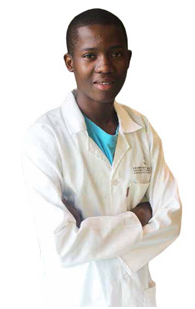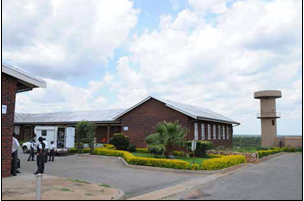Eighteen-year-old Sechaba Ramerafe has ambitions of becoming a doctor.
 He is currently in his first year at university, studying towards a Biological Science degree at the University of Pretoria but will change his course in the second semester to achieve his dream.
He is currently in his first year at university, studying towards a Biological Science degree at the University of Pretoria but will change his course in the second semester to achieve his dream.
Ramerafe’s ambitions seemed a long way off, growing up in the farming village of Slurry in the North West, where he attended the Onkgopotse Tiro Comprehensive School.
But hard work and support from his teachers and family helped him breeze through his matric exams and achieve five distinctions in 2013. He was also at the top of his class.
Ramerafe explains that completing his matric was difficult and there were times when he thought of dropping out of school because of the poverty he had to deal with at home.
His mother is a domestic worker and father is unemployed. Ramerafe has six siblings and is the first in his family to attend university.
“I never saw myself completing matric because of my background. My standard of living was very poor. I did not think I would get anywhere in life,” he says.
The school he attended is a no-fee school for members of the community who are vulnerable but the class of 2013 still managed to produce a 100 per cent matric pass rate. More than eight million children now benefit from the no-fee policy.
Ramerafe and his classmates were among the matriculants who did the country proud, achieving a 78.2 per cent pass rate.
The Twenty Year Review released by the Presidency, notes that the matric pass rate has improved over the years and that more learners are also attending higher education institutions.
 “On average, between 2010 and 2012, 128 000 learners obtained bachelor passes, compared with 70 000 per year for the period 2000 to 2002,” the review says.
“On average, between 2010 and 2012, 128 000 learners obtained bachelor passes, compared with 70 000 per year for the period 2000 to 2002,” the review says.
The matric pass rate has steadily increased over the past 20 years from 53.4 per cent in 1995 to 78.2 per cent in 2013.
The review attributes the improved pass rate to increased matric support programmes offered by the Department of Basic Education, as well as non-government organisations and the private sector.
This support includes intensive post-test analysis of question papers, self-study guides in selected subjects, revision camps for learners and supplementary winter schools, radio and television lessons in key subjects and the availability of examination examples and teacher support.
According to the review, the improvement in the pass rate is also because of a stabilised education system, which is no longer experiencing rapid changes in curriculum or policies.
All these interventions helped the class of 2013 achieve success, particularly those in the North West, where the matric pass rate increased from 50 per cent in 1997 to 87.2 per cent in 2013.
As for Ramerafe, he wants to return to the North West one day to give back to his community.
“I want to be a doctor to help the people of my village and later specialise in neurosurgery. I think that the brain has many secrets that still need to be discovered and I hope to discover these,” he said.



 Facebook
Facebook Twitter
Twitter WhatsApp
WhatsApp